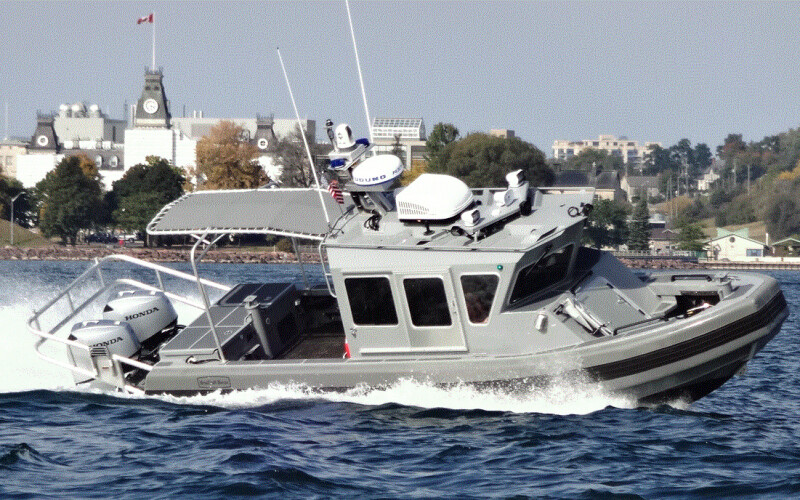The days of creating patrol boats by outfitting general-use motorboats and fishing trawlers with machine guns and obsolete naval weapons are long gone. That was World War II.
Jump ahead 80 years, and patrol boats have evolved into platforms that have the latest navigation, communications, and propulsion systems while being designed and built with highly efficient hulls that move easily and rapidly through the water and can carry out multiple missions in locations across the globe.
Three cases in point: MetalCraft Marine is building 65 patrol boats that will mostly operate in foreign waters; a high-speed 35-footer from Moose Boats that’s outfitted with fire-fighting systems; and Inventech Marine Solutions’ 40' patrol boat for a sheriff’s department in Florida, which hits 72 mph.
MetalCraft Marine
MetalCraft Marine, Cape Vincent, N.Y., working on a contract with the U.S. Navy to design and build 45 Force Protection Small (27'x8'6") and 20 Force Protection Large (39'6"x12') patrol boats, recently delivered a 27-footer to the Navy and is due to deliver a 39-footer. The Navy’s Force Protection program evolved from the attack on the guided-missile destroyer USS Cole in the Yemeni port of Aden on Oct. 12, 2000, that killed 17 Americans.
Eventually, when American military vessels dock in potentially hazardous ports, “there will be two (Force Protection) boats for every ship,” said MetalCraft Marine’s Bob Clark. “No one’s getting near them.”
The American military vessel will have a large sonoboom around it with sonobuoys at the ends of cables that reach almost to the bottom to detect an unwanted presence. A Force Protection patrol boat will open the boom when deliveries are being made to a ship and then close it when completed. The 39' Force Protection vessels, with four machine-gun posts, will be stationed in remote, open ports, such as Guam in the Western Pacific and Diego Garcia in the Indian Ocean. The 27' Force Protection vessels, with two machine gun posts, will work out of enclosed harbors.
Clark said a prominent design feature of the Force Protection vessel is comfort. “The Navy has finally realized they can’t have someone in Middle East heat for 12 hours and expect them to be very fit and functional,” he said.
The same consideration goes for cold weather. “Crutching yourself up to keep body heat in is very fatiguing.” Thus, all the boats will have generators for air conditioning, “which is very rare for an 8 meter,” and diesel heaters for cold weather deployment.
Force Protection patrol boats are powered by outboards — Mercury, Yamaha, and Honda. The 27-footers get twin 150-hp outboards and the 39-footers twin 175-hp outboards. Clark noted that the contract stated that “they could not exceed 35 knots,” which is why, he said, “they are very light on horsepower.” Whereas “years ago, every patrol boat would be 50 knots.” Then horsepower levels started dropping to 45 knots, 40, 38 knots, and now 35 knots. The reason was often “horseplay. Kids do stupid things,” Clark said, often “bumping up against another boat. Doing it for fun.”
Moose Boats
Moose Boats, Vallejo, Calif., is scheduled to deliver a new 35'x13'6" patrol boat to Santa Barbara, Calif.’s Harbor Patrol in the first quarter of 2025. This will be more than just a high-speed chase down the bad guys' vessel.
“They focused on a boat that could do many things, go fast for law enforcement, a rescue boat, and fire-suppression boat,” said Moose Boats’ vice president of sales, Ken Royal,
The all-aluminum Moose Boats Model M2 catamaran hull will have a pair of 300-hp Cox Marine diesel outboards. With the Cox diesels, Royal described the 35-footer “as a bit of a go-fast boat.” He’s anticipating 38 knots top speed and 32 knots cruising. That’s good when the Santa Barbara Harbor Patrol needs to get somewhere in a hurry, and when that’s related to a fire suppression mission, it is, as Royal noted, “much safer to respond to a fire incident with a diesel-powered boat than gasoline-powered.”
Another Moose Boats M2 design feature that Royal emphasized was the catamaran hull. “Our boats, rather military, patrol, or fireboats, are stable because they are catamarans. That’s where we have a pretty good niche.” Being a catamaran, as opposed to a monohull, “you can put a lot of weight in various places on deck and not be concerned where you put that weight.”
The catamaran’s fairly generous beam also allows for a walk-around cabin configuration between the gunnels and the cabin.
Inside the wheelhouse will be three shock-mitigating seats from Shoxs and a patient’s bench. The electronics package will center on a Raymarine Axiom 12 Pro hybrid multifunction display with chartplotter, radar, GPS, depth sounder, and 3-D sonar.
Outside the cabin on the hull’s port aft-quarter, will be “a proprietary dive door that telescopes out and down into the water,” said Royal. It has steps, allowing someone to come out of the water and walk onto the boat. It can then be collapsed on itself, becoming part of the hull. On the starboard quarter a board can be lifted up, allowing swimmers to be pulled onto the deck.
When the call is to extinguish a fire, the 35-footer will have two 1,500 gpm Task Force Tips fire monitors, one on top of the cabin, the other in front of the cabin. When encountering a pier fire, the bow’s large push knee allows the bow to push and hold against a pylon. “to secure the vessel in place while throwing water at the fire,” said Royal.
Inventech Marine Solutions
Inventech Marine Solutions, Bremerton, Wash., delivered a 40'x11'6" patrol boat with a foam-collar system to the sheriff’s department in Palm Beach County, Fla., this past December. It’s the third patrol boat Inventech has sent to the Palm Beach County Sheriff’s Department.
The 40-footer is powered by four 400-hp Mercury V10 Verado outboards that when matched up with Inventech’s aluminum hull with a deep 22° deadrise at the transom and what Inventech Marine Solutions’ CEO Micah Bowers said is a “really refined entry,” was “able to do top speeds of 71 to 72 mph.”
Wheelhouse electronics include a 32", flat-screen TV that allows viewing videos coming in from other vessels and tracking all inputs to their department. It’s integrated into the night-vision camera system and the onboard Garmin’s. “So tactical team members can navigate with chart plotting screen or with night vision camera looking for someone in the water while underway.” When not in use, the screen is electrically lowered into its cabinet.
Wheelhouse refinements include the use of Mercury’s new fully electric smart cylinders for steering. “It’s the very first boat we ever built with the smart cylinders,” said Bowers. The Florida sheriff’s department “wanted a steering system that’s instantaneous feedback between “input at the steering wheel to the motion at the outboards.” With the previous Mercury electronic helm, the sheriff’s department “felt in tactical situations it was not as responsive as they needed.” In contrast, the new steering system was judged to be “exceptionally responsive. They thought it was premier. They also said the boat’s performance in a tactical situation was the best they’d experienced.”




